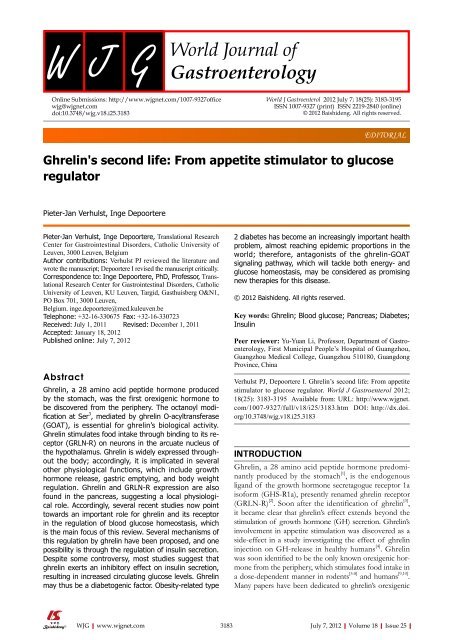Ghrelin's second life - World Journal of Gastroenterology
Ghrelin's second life - World Journal of Gastroenterology
Ghrelin's second life - World Journal of Gastroenterology
You also want an ePaper? Increase the reach of your titles
YUMPU automatically turns print PDFs into web optimized ePapers that Google loves.
Online Submissions: http://www.wjgnet.com/1007-9327<strong>of</strong>fice<br />
wjg@wjgnet.com<br />
doi:10.3748/wjg.v18.i25.3183<br />
<strong>Ghrelin's</strong> <strong>second</strong> <strong>life</strong>: From appetite stimulator to glucose<br />
regulator<br />
Pieter-Jan Verhulst, Inge Depoortere<br />
Pieter-Jan Verhulst, Inge Depoortere, Translational Research<br />
Center for Gastrointestinal Disorders, Catholic University <strong>of</strong><br />
Leuven, 3000 Leuven, Belgium<br />
Author contributions: Verhulst PJ reviewed the literature and<br />
wrote the manuscript; Depoortere I revised the manuscript critically.<br />
Correspondence to: Inge Depoortere, PhD, Pr<strong>of</strong>essor, Translational<br />
Research Center for Gastrointestinal Disorders, Catholic<br />
University <strong>of</strong> Leuven, KU Leuven, Targid, Gasthuisberg O&N1,<br />
PO Box 701, 3000 Leuven,<br />
Belgium. inge.depoortere@med.kuleuven.be<br />
Telephone: +32-16-330675 Fax: +32-16-330723<br />
Received: July 1, 2011 Revised: December 1, 2011<br />
Accepted: January 18, 2012<br />
Published online: July 7, 2012<br />
Abstract<br />
Ghrelin, a 28 amino acid peptide hormone produced<br />
by the stomach, was the first orexigenic hormone to<br />
be discovered from the periphery. The octanoyl modification<br />
at Ser 3 , mediated by ghrelin O-acyltransferase<br />
(GOAT), is essential for ghrelin’s biological activity.<br />
Ghrelin stimulates food intake through binding to its receptor<br />
(GRLN-R) on neurons in the arcuate nucleus <strong>of</strong><br />
the hypothalamus. Ghrelin is widely expressed throughout<br />
the body; accordingly, it is implicated in several<br />
other physiological functions, which include growth<br />
hormone release, gastric emptying, and body weight<br />
regulation. Ghrelin and GRLN-R expression are also<br />
found in the pancreas, suggesting a local physiological<br />
role. Accordingly, several recent studies now point<br />
towards an important role for ghrelin and its receptor<br />
in the regulation <strong>of</strong> blood glucose homeostasis, which<br />
is the main focus <strong>of</strong> this review. Several mechanisms <strong>of</strong><br />
this regulation by ghrelin have been proposed, and one<br />
possibility is through the regulation <strong>of</strong> insulin secretion.<br />
Despite some controversy, most studies suggest that<br />
ghrelin exerts an inhibitory effect on insulin secretion,<br />
resulting in increased circulating glucose levels. Ghrelin<br />
may thus be a diabetogenic factor. Obesity-related type<br />
WJG|www.wjgnet.com<br />
<strong>World</strong> J Gastroenterol 2012 July 7; 18(25): 3183-3195<br />
ISSN 1007-9327 (print) ISSN 2219-2840 (online)<br />
© 2012 Baishideng. All rights reserved.<br />
2 diabetes has become an increasingly important health<br />
problem, almost reaching epidemic proportions in the<br />
world; therefore, antagonists <strong>of</strong> the ghrelin-GOAT<br />
signaling pathway, which will tackle both energy- and<br />
glucose homeostasis, may be considered as promising<br />
new therapies for this disease.<br />
© 2012 Baishideng. All rights reserved.<br />
Key words: Ghrelin; Blood glucose; Pancreas; Diabetes;<br />
Insulin<br />
Peer reviewer: Yu-Yuan Li, Pr<strong>of</strong>essor, Department <strong>of</strong> <strong>Gastroenterology</strong>,<br />
First Municipal People’s Hospital <strong>of</strong> Guangzhou,<br />
Guangzhou Medical College, Guangzhou 510180, Guangdong<br />
Province, China<br />
Verhulst PJ, Depoortere I. Ghrelin’s <strong>second</strong> <strong>life</strong>: From appetite<br />
stimulator to glucose regulator. <strong>World</strong> J Gastroenterol 2012;<br />
18(25): 3183-3195 Available from: URL: http://www.wjgnet.<br />
com/1007-9327/full/v18/i25/3183.htm DOI: http://dx.doi.<br />
org/10.3748/wjg.v18.i25.3183<br />
INTRODUCTION<br />
EDITORIAL<br />
Ghrelin, a 28 amino acid peptide hormone predominantly<br />
produced by the stomach [1] , is the endogenous<br />
ligand <strong>of</strong> the growth hormone secretagogue receptor 1a<br />
is<strong>of</strong>orm (GHS-R1a), presently renamed ghrelin receptor<br />
(GRLN-R) [2] . Soon after the identification <strong>of</strong> ghrelin [3] ,<br />
it became clear that ghrelin’s effect extends beyond the<br />
stimulation <strong>of</strong> growth hormone (GH) secretion. Ghrelin’s<br />
involvement in appetite stimulation was discovered as a<br />
side-effect in a study investigating the effect <strong>of</strong> ghrelin<br />
injection on GH-release in healthy humans [4] . Ghrelin<br />
was soon identified to be the only known orexigenic hormone<br />
from the periphery, which stimulates food intake in<br />
a dose-dependent manner in rodents [5-8] and humans [9,10] .<br />
Many papers have been dedicated to ghrelin’s orexigenic<br />
3183 July 7, 2012|Volume 18|Issue 25|

















